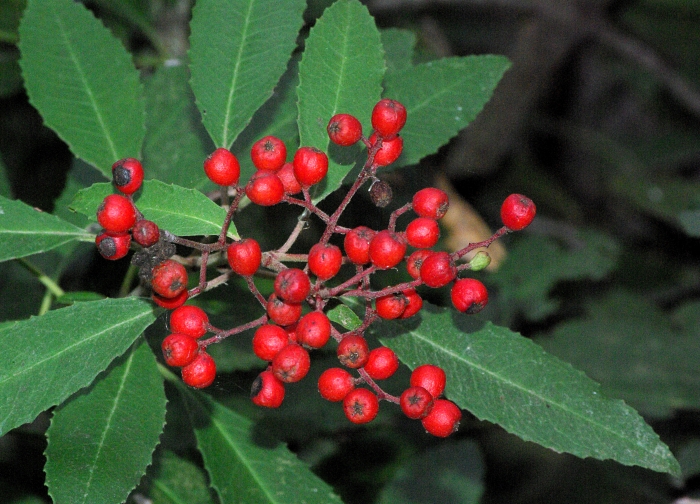Toyon
(Heteromeles arbutifolia)
Toyon (Heteromeles arbutifolia)
/
/

ALAN SCHMIERER
CC0
Image By:
ALAN SCHMIERER
Recorded By:
Copyright:
CC0
Copyright Notice:
Photo by: ALAN SCHMIERER | License Type: CC0 | License URL: http://creativecommons.org/publicdomain/zero/1.0/deed.en | Uploader: Fæ | Publisher: Wikimedia Commons | Title: TOYON_(heteromeles_arbutifolia)_(3-24-07)_canet_(535371030).jpg | Notes: User created page with UploadWizard |












































































Estimated Native Range
Summary
Heteromeles arbutifolia, commonly known as Toyon, Christmas berry, or California holly, is an evergreen shrub or small tree native to California and Baja California, Mexico. It is a key species in chaparral, coastal sage scrub, and mixed oak woodland ecosystems, often found on dry, sunny slopes. Toyon typically grows 8-15 feet (2.4-4.5 meters) tall and wide, with a dense, rounded form. The leaves are leathery, dark green, and serrated. Clusters of small, white flowers bloom in early to mid-summer and are moderately showy. By late fall and winter, the plant is adorned with bright red berries, which are particularly attractive to birds and other wildlife.
Toyon is valued for its drought tolerance and year-round interest, making it a popular choice for native plant gardens, wildlife gardens, and as a fire-resistant landscaping plant. It is also used for erosion control on slopes. While Toyon is adaptable to various soil types, it thrives in well-drained soils and prefers full sun to part shade. Once established, it requires little maintenance and is quite resilient to pests and diseases. However, it can suffer from root rot in poorly drained soils. Toyon has been successfully cultivated in regions with similar Mediterranean climates, such as Southern England, due to its tolerance of low temperatures down to -12 °C.CC BY-SA 4.0
Toyon is valued for its drought tolerance and year-round interest, making it a popular choice for native plant gardens, wildlife gardens, and as a fire-resistant landscaping plant. It is also used for erosion control on slopes. While Toyon is adaptable to various soil types, it thrives in well-drained soils and prefers full sun to part shade. Once established, it requires little maintenance and is quite resilient to pests and diseases. However, it can suffer from root rot in poorly drained soils. Toyon has been successfully cultivated in regions with similar Mediterranean climates, such as Southern England, due to its tolerance of low temperatures down to -12 °C.CC BY-SA 4.0
Plant Description
- Plant Type: Shrubs, Trees
- Height: 6-30 feet
- Width: 6-18 feet
- Growth Rate: Rapid
- Flower Color: White
- Flowering Season: Summer
- Leaf Retention: Evergreen
Growth Requirements
- Sun: Full Sun, Part Shade
- Water: Low
- Drainage: Fast, Medium, Slow
Common Uses
Bee Garden, Bird Garden, Butterfly Garden, Deer Resistant, Drought Tolerant, Erosion Control, Fire Resistant, Hedges, Low Maintenance, Rabbit Resistant, Rock Garden, Showy Flowers, Street Planting
Natural Habitat
Chaparral, coastal sage scrub, and mixed oak woodland ecosystems
Other Names
Common Names: California Holly , Christmas Berry , Winterbeere , Tollon
Scientific Names: Heteromeles arbutifolia , Photinia arbutifolia , Heteromeles salicifolia , Photinia salicifolia , Crataegus arbutifolia , Crataegus serrata , Crataegus serrulata , Mespilus arbutifolius , Heteromeles fremontiana , Photinia foliolosa
GBIF Accepted Name: Heteromeles arbutifolia (Lindl.) M.Roem.